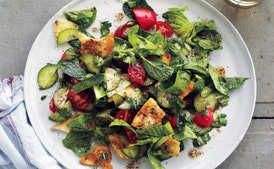Introduction
Fattoush is a vibrant, fresh Levantine salad that epitomizes the spirit of communal eating with its delightful blend of crunchy vegetables, tangy dressing, and toasted pita bread. Originating from Palestine, this dish has gained immense popularity across the Middle East for its balanced flavors and simple ingredients that come together in perfect harmony. The traditional Fattoush is not just a meal but an experience—each bite offers a medley of textures and tastes that invigorate the senses.
Tips for this Recipe
To make your own version of Fattoush, ensure each ingredient is prepared with care to maintain its freshness: soak sumac in warm water as it’s essential for that characteristic lemony zest. The pomegranate molasses adds a delightful sweet-tart depth; adjusting the amount can alter the salad’s flavor profile significantly. For best results, use ripe vegetables and high-quality oils to enhance the dish’s authentic taste and healthfulness.
Why You Will Love This Recipe
Fattoush stands out for its refreshing crunch, which is complemented by a burst of flavors in every mouthful. It’s not only incredibly satisfying but also an excellent canvas to add your favorite ingredients or personal touches while still staying true to the classic recipe. Its simplicity and versatility make it appealing for all occasions—whether as a light lunch, an appetizer at a gathering, or a side dish that brings life to any meal.
Ingredients
– 4 teaspoons ground sumac, soaked in warm water
– Soaking liquid from sumac (approx. 4 teaspoons)
– 3 tablespoons fresh lemon juice or more to taste
– 2 tablespoons pomegranate molasses or adjusted quantity for sweetness level
– 2 small garlic cloves, minced
– 2 teaspoons white wine vinegar
– 1/2 teaspoon dried mint
– Extra-virgin olive oil (3/4 cup)
– Kosher salt to taste
– Toasted pita bread pieces: 1/4 cup extra-virgin olive oil, kosher salt for seasoning
– Fresh produce including: tomatoes, cucumbers, scallions, lettuce (Parsley, purslane or Romaine), and mint. Approximately:
3 medium ripe tomatoes, chopped; 1 pound Persian cucumbers, quartered lengthwise and sliced crosswise; 6 scallions thinly sliced; 2 Little Gem or baby romaine lettuce head cut into strips.
– Fresh herbs: 2 cups parsley leaves, 1 cup purslane or additional Romaine lettuce for texture.
– Optional: ground sumac (for garnishing)
Advised Equipment
For assembling this dish, a precision cooktop/stove with even heat distribution is essential. Equip yourself with the following tools to ensure culinary success:
– Nonstick frying pan (12-inch)
– Digital food scale for precise ingredient measurements
– Cutting board (Masonite preferred)
– Chef’s Knife
– Oven mitts and dish towels set
– Mixing bowls in various sizes
History of the Recipe
Fattoush has been a staple across the Levant for centuries, with its origins steeped in the rich tapestry of Middle Eastern cuisine. Traditionally made by families and served at social gatherings, this salad is more than just food; it’s a symbol of hospitality and sharing among friends and loved ones. Through generations, variations have emerged based on regional availability of ingredients and personal preferences, making Fattoush an evolving yet timeless dish that continues to unite people through its flavors and communal spirit.
Fun Facts About This Recipe
Did you know? Fattoush’s inclusion of fried bread has given it the name ‘Fat Souk’, which translates to ‘bread souq’. It was originally a street food popular in Aleppo, Syria. The use of fresh produce and herbs not only lends this salad its vibrant color but also emphasizes the importance of seasonal eating—a concept deeply rooted in Middle Eastern culture. Moreover, Fattoush’s adaptability is highlighted by its variations that reflect local tastes and ingredients, showcasing regional pride through culinary traditions.
